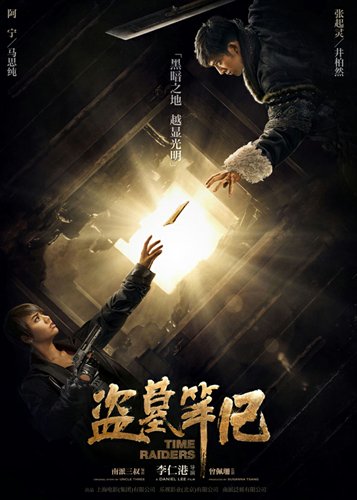Censorship a hurdle for tomb raiding book adaptations

Promotional material for Time Raiders Photo: CFP
Fascinated by mysterious experiences that most people can only dream of, Chinese audiences have fallen in love with tomb raiding films and TV productions.
While reviews have been mixed, fantasy-suspense film Time Raiders' opening day box office of 163 million yuan ($24.4 million) and weekend revenue of 435 million yuan have made it the savior of this summer's lukewarm mainland box office.
Adapted from best-selling novel Daomu Biji (The Grave Robbers' Chronicles), Time Raiders is one of the many tomb raiding films and TV dramas that have become extremely popular in China in recent years. While this genre isn't a new one in China nor the rest of the world, these more recent works seem to have been deeply influenced by Hollywood productions.
The 'Scooby-Doo' effect
Currently holding a 5.8/10 on mtime.com and a 4.9/10 on movie.douban.com, the two most popular film websites in China, Time Raiders has been very polarizing when it comes to reviews. While some admire the setting and attention to detail when it comes to creating scary environments, others have complained that the film's world-building and characters come across as weak.
It seems mixed critical responses and high box office returns go hand in hand when it comes to recent tomb raiding films.
Chronicles of the Ghostly Tribe (2015), adapted from the first four books of popular tomb raiding novel Ghost Blows Out the Light, made 682.80 million yuan in the mainland. Yet, the film was also heavily criticized by audiences when it came to creating a believable world and characters, as well as changing the "ghosts" from the original novel into dog-like monsters.
Mojin - The Lost Legend (2015), an adaptation of the latter four books of Ghost Blows Out the Light, may be the highest grossing tomb raiding film so far, but its 1.68 billion mainland box office did nothing to stop criticism of the film.
In response to many of these criticisms, many industry insiders have complained that content restrictions from China's media watchdog, the State Administration of Press, Publication, Radio, Film and Television (SAPPRFT), have been one of the major roadblocks that have prevented them from producing a satisfying film.
For example, while supernatural elements such as ghosts and zombies are allowed in books, these elements must have a reasonable scientific explanation in films. So far this has caused the scary elements from the books getting a sort of "Scooby-Doo" effect, where the ghosts turn out to be someone in disguise, or the zombies coming back to life turn out to be hallucinations.
Films also have to convey appropriate messages, so the tomb raiders that are simply looking for treasure in the books end up having more altruistic motivations for breaking into tombs in the films or TV shows.
Although content restrictions have had an impact, SAPPRFT is not solely to blame for the poor critical performance of these works, as the rules about supernatural elements are not the only fatal factors behind a film's failure.
"The special effects of Chinese tomb raiding films are too Western. They lack our own imagination," Zhou Yu, a scriptwriter and film producer, commented.
The problem of heavily copying Hollywood elements isn't just a problem for China's tomb raiding genre. Recent fantasy films in China have also been criticized for being "too Western."
Return to tradition
Tomb raiding films were once extremely popular in Hollywood. Classic works like the National Treasure franchise, The Mummy franchise and the two Tomb Raider films all fall under this genre.
Neither is it a new genre in China.
In the 1980s and 1990s, archeological adventures made for an interesting topic for filmmakers to explore. Representative films in this genre include The Magic Crystal (1986), The Night Robbery (1990) and Dream Broken at the Ancient Town of Loulan (1991).
A subset of the larger adventure genre, today's new works are not all that different from their predecessors. In fact both the Chinese and Hollywood films seem to follow the same template: a group or individual goes searching through tombs for treasure or the secret to eternal life, but the main character ends up discovering something even more valuable. And of course the fight between the heros and villains is indispensable.
Of course, newer films aren't carbon copies of older films. For instance, compared with older Chinese works, these new Chinese films have more of a Hollywood blockbuster feel to them in order to be good popcorn flicks.
They also tend to feature more traditional Chinese knowledge and philosophy. Even though this can sometimes make the film difficult for even Chinese audiences to understand, they successfully build that air of mystery which is essential to a tomb raiding film.
Newspaper headline: Secrets under the Earth